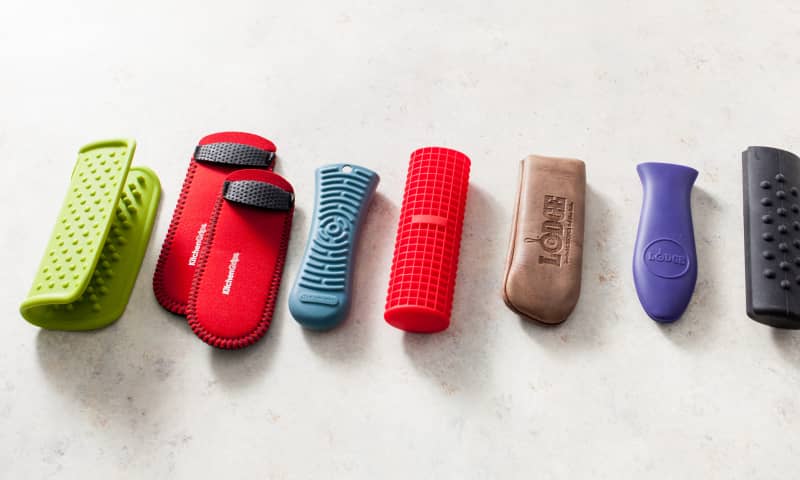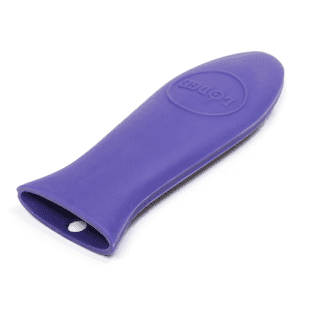We love cast-iron skillets for their superior heat retention, which allows them to excel at searing, browning, and shallow-frying. But because they get and stay so hot, they can also be tricky to handle—not just while they're on the stove or in the oven but long after they're off or out of the heat. Handle covers promise to protect your hands from the hot metal, making these pans easier and safer to use. Most covers can't be put in the oven, though they can be used to remove pans that have been heated there; instead, they're intended primarily for stovetop cooking projects.
Instructions on how to use these covers differ. Some manufacturers recommend that they be used like potholders, slipped over the handle only when you need to maneuver the skillet and then promptly removed. Others say that they should go on the handle and stay there throughout your meal preparation, preventing you from accidentally grabbing the handle unguarded. Since these instructions are not always made clear to consumers, we decided to test handle covers both ways, investigating five models, in various sizes, shapes, and materials (four were made from silicone and one from leather with a synthetic lining).

Beating the Heat
We soon learned that it was not a good idea to keep any cover on the skillet handle throughout use. As long as the cover stays in contact with the handle, it will steadily absorb the handle's heat. When we put each cover on a cast-iron skillet handle and heated the skillet over a medium-high flame, all models reached 110 degrees—the temperature our testers found too hot to grip—within 18 minutes. In practice, that means that the most heat-resistant covers give you just enough time to make fried eggs, but not enough to pan-fry pork chops or complete the first steps of many other cast iron recipes. What's more, some of the models melted or scorched when left on for longer than 5 minutes while the skillet was on the stovetop.

The covers fared better when used like potholders, put on the handles only when needed and then taken off. After heating the cast-iron skillets over a medium-high flame for 20 minutes—this time without the covers—we put the covers on and used them to take the skillets off the heat, as if to scrape the contents into a bowl. All the covers stayed under 110 degrees for at least 30 seconds, ample time to grip and lift the skillet, and our first- and second-place models were comfortable to hold for considerably longer—6½ and 2½ minutes, respectively.
Similarly, the covers did a decent job when used to remove a cast-iron skillet holding a roast chicken from a 450-degree oven; each model was cool enough to grip for the 10 seconds or so that it took to put the whole shebang on a wire rack. That said, we wouldn't advise leaving them on longer; within 30 to 90 seconds of sitting on the scorching hot handle, all the covers had reached 110 degrees. And be forewarned: Because the cast-iron skillet itself is so heavy, especially when weighed down with a chicken, you'll still need another potholder or mitt to grab the other side of the skillet to get the chicken out of the oven in the first place.

Room for Improvement
Our preferences also came down to the way the covers fit the handles. Simply put, most just didn't fit very well. Of the silicone covers, two were too loose—easy to slip onto a hot skillet handle but hard to grip securely. The other two silicone models were too tight, requiring us to brace the skillet with a potholder in order to jam the cover on the handle—a somewhat dicey maneuver when you're dealing with hot cast iron. In addition, all the models except one were too long for both our traditional and enameled cast-iron skillet handles, making it hard to see where the handle began and ended underneath, and in some cases preventing us from getting a secure grip.
Design mattered, too. Three of the silicone covers had bumps or ridges on their tops and bottoms, in theory to help keep our hands a little higher off the hot metal there; unfortunately, they lacked similar bumps on the sides, so our hands still got hot pretty fast. (The fourth silicone model had no bumps at all, its smooth surface providing a fairly thin buffer against the heat.)
Our favorite model, the Lodge Nokona Leather Handle Holder, is a leather sheath lined with a thick swath of aramid, a heat-resistant fiber. That thick liner solves two problems at once. It acts as insulation, helping keep our hands in the comfortable range for 6½ minutes when we put it on to remove the hot pan from the stove. It also ensures a snug but not-too-tight fit, making it easy to slip onto a handle yet still relatively secure to grip. While we don't recommend that you keep it—or any other handle cover—on the skillet during cooking, our winner makes a handy and slightly more dextrous alternative to a potholder or oven mitt.
The Tests
- Put handle cover on cast-iron skillet and then gradually heat skillet over medium-high heat, taking temperature of handle cover every minute
- Heat cast-iron skillet for 20 minutes over medium-high heat, then put on handle cover and maneuver skillet, timing how long it takes for cover to reach 110 degrees
- Roast chicken in cast-iron skillet at 450 degrees, then use handle cover to transfer skillet to wire rack. Take cover's temperature initially and at 30-second intervals until it reaches 110 degrees
Hoe We Rated
- Heat Protection: We evaluated how quickly the covers reached an intolerable temperature (110 degrees) in all applications.
- Fit: We evaluated how well the covers fit, seeing how easy they were to get on and off the skillets and how secure they were to grip.
- Fits cast-iron skillet handles snugly
- Easy to put on and remove from handle
- Provides good heat resistance when used like potholder









